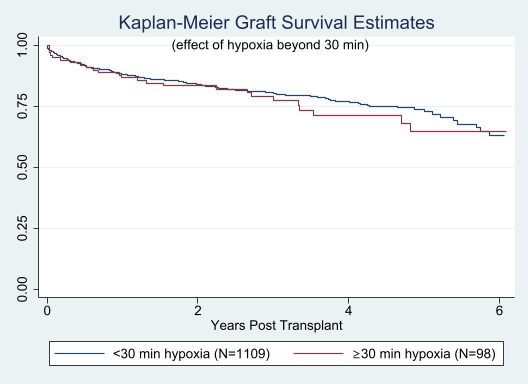Oxygen Saturation During Donor Warm Ischemia Time and Outcome of Donation After Circulatory Death (DCD) Liver Transplantation: A Review of 1207 Cases
S. Duehren, S. J. Cotler, H. Dahari, Z. Shi, C. Joyce, L. Fernandez, D. Lee
Loyola Univ Chicago, Maywood, IL
Meeting: 2022 American Transplant Congress
Abstract number: 225
Keywords: Donors, non-heart-beating, Liver transplantation
Topic: Clinical Science » Liver » 59 - Liver: Expanding the Donor Pool* (Liver: MELD Allocation / Donor Issues)
Session Information
Session Name: Expanding the Donor Pool (MELD Allocation/Donor Issues)
Session Type: Rapid Fire Oral Abstract
Date: Monday, June 6, 2022
Session Time: 3:30pm-5:00pm
 Presentation Time: 3:30pm-3:40pm
Presentation Time: 3:30pm-3:40pm
Location: Hynes Room 312
*Purpose: Donation after circulatory death (DCD) liver transplantation (LT) is associated with increased risk of graft failure due to the donor warm ischemia time (DWIT) associated with donation. Functional donor warm ischemia time (fDWIT), which begins when the donor oxygen saturation (O2sat) drops below 80% or the systolic blood pressure is below 50, is an important variable in the UK DCD risk score. The aim of this study was to evaluate the impact of prolonged hypoxemia during DCD withdrawal on graft survival at transplant programs experienced in using DCD organs.
*Methods: Donor withdrawal data from the UNOS STAR file was reviewed from DCD livers that were used by the 20 largest DCD centers in the United States from 2014-2018. Oxygen saturation curves were reviewed and time spent with O2sat <80% was quantified. We sought to investigate the impact of O2sat below 80% for ≥30 minutes on post transplant outcomes. Other variables including donor age, cold ischemia time, recipient age, recipient MELD, retransplantation, total DWIT, and fDWIT were investigated in Cox proportional hazards regression analyses.
*Results: The 20 highest DCD volume centers in the US performed 1296 DCD transplants (61% of all DCD LT) during the study period. Data were available for 1207 donors. Overall graft survival was 78.7% with a mean follow up time of 2.6 (+ 1.6) years. Mean DWIT was 23.4 (+ 6.8) minutes. On average, patients entered the agonal period 2.5 min (+ 2.5) from withdrawal, and the mean fDWIT was 20.8(+ 7.0) minutes. 98 donors spent > 30 minutes with an O2sat <80%. Cumulative graft survival was similar between patients with greater than or less than 30 minutes of 02sat <80% (Figure). Compared to those with < 30 minutes of O2sat < 80%, those with ≥30 minutes had similar hazard of graft failure in unadjusted (HR:1.13, 95% CI: 0.75-1.70) and age and retransplantation adjusted (1.14, 95% CI: 0.75-1.73) analyses. In the multivariable model, hazard of graft loss was 13% greater for each 10 year increase in age (HR: 1.13, 95% CI: 1.03-1.24) and also significantly greater for those with retransplantation (HR: 3.59, 95% CI: 1.47-8.76).
*Conclusions: In a review of 1207 DCD LT performed from 2014-2018, DWIT spent with an O2sat of <80% was not associated with an increased risk of graft loss. Organs from donors with hypoxia >30 min during procurement provided acceptable outcomes.
To cite this abstract in AMA style:
Duehren S, Cotler SJ, Dahari H, Shi Z, Joyce C, Fernandez L, Lee D. Oxygen Saturation During Donor Warm Ischemia Time and Outcome of Donation After Circulatory Death (DCD) Liver Transplantation: A Review of 1207 Cases [abstract]. Am J Transplant. 2022; 22 (suppl 3). https://atcmeetingabstracts.com/abstract/oxygen-saturation-during-donor-warm-ischemia-time-and-outcome-of-donation-after-circulatory-death-dcd-liver-transplantation-a-review-of-1207-cases/. Accessed December 23, 2025.« Back to 2022 American Transplant Congress

